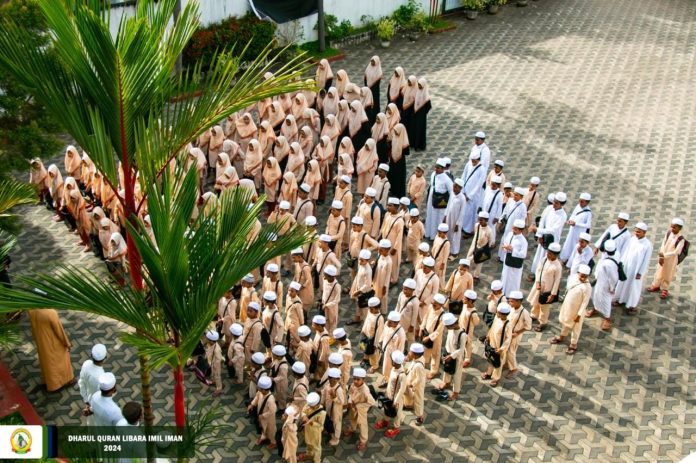– Arshad Shaikh
In an era marked by rapid technological advances and unrelenting media onslaught, madrasas or Islamic schools of learning are often misunderstood, misinterpreted and unfairly portrayed. They are frequently generalised negatively and criticised for being regressive, isolated and stuck in the past. However, few of us have real experience about madrasas, as very rarely have any of us actually stepped into them and observed them at close quarters. Let us understand how a typical day in the madrasa unfolds.
The Sacred Dawn: Pre-Fajr Devotion
A typical day in the madrasa begins long before the rest of the world stirs. Many madrasas have students (talib = student/learner, tulba = plural of student, and Taliban = students in the Pashto language) who memorise the Qur’an. The budding huffaz (a Hafiz is a one who has memorised the complete Quran) wake up a full hour before the Fajr (dawn) prayer. This time known as “Tahajjud” is considered especially blessed in Islamic tradition and hence students take advantage of this tranquil timeframe and begin revising and learning the verses of the Quran that they had memorised the night before. Their teachers (muallimeen) too arrive early and listen to their students and evaluate their progress and performance. Madrasa students, driven by devotion also offer Tahajjud voluntary night prayers, seeking Allah’s help and blessings and doing duas for themselves, their families, community and humanity at large.
Morning Prayers and Reflections
As the call to prayer echoes through the corridors, students gather for Fajr Salah. The congregational prayer is followed by a short session of spiritual readings and collective supplication (ijtemai dua). Chapters of the Qur’an like Surah Yaseen, and Surah Al-Waqi’ah are recited. Traditional invocations and heartfelt du‘as are made for the well-being of the Ummah and family. It is a reflective time that brings students closer to their Creator. Then students take a short break to freshen up. Breakfast is a simple, nutritious meal before the academic day formally begins.
The Assembly
Typically, madrasas organise a brief morning assembly before classes begin. The bell rings and students gather to sing the tarana or anthem. They listen to a short Hadith with its translation, explanation, and announcements about upcoming activities. The daily gathering sets the tone for the day and students feel purposeful, spiritual, and grounded. Madrasas rotate the content of the session between a Hadith, poem, or story of a companion of the Prophet ﷺ. A motivational talk is usually included to make the session engaging and educational.
Balanced Curriculum
There are various misconceptions that madrasas only teach religious texts. In reality, they have dual curriculum that goes beyond just religious texts. They teach both traditional Islamic sciences and modern secular education.
Classes begin at 8 AM, continuing until midday. Subjects include Qur’an memorisation, Hadith studies, Arabic grammar (Nahw), logic (Mantiq), and jurisprudence (Fiqh). Simultaneously, English, Mathematics, and Science are taught. Computer Applications are also included in numerous institutions. In Kerala, Hyderabad, and North India, many madrasas are affiliated with state education boards. Students appear for matriculation and higher secondary exams through these boards. The goal is to nurture students who are spiritually rooted, intellectually versatile and socially aware.
The Jam-Packed Day
After the rigorous morning session, students offer the Zuhr prayer in congregation. This is followed by lunch, which is eaten together in large dining halls. The meal is simple, its quality depending on the financial situation of the madrasa. A short rest period follows the midday meal which recharges them for the demanding afternoon ahead. 2:30 PM to 5:00 PM classes resume Tafsir i.e. exegesis the Qur’an, Islamic history, advanced grammar is taught. The lessons are tailored according to the age and intellectual level of the students. After the Asr (late afternoon) prayer, students relax playing outdoor games, reading, personal chores. This serves as a time for relaxation and rejuvenates them both physically and mentally. After the Maghrib (sunset prayer), students again do some quiet revision of Quranic recitation and then dinner is served shortly thereafter.
The final leg of the day concludes with the Isha (night prayer) and a short study session. Senior students revise their academics independently in designated circles for group study. Around 10 PM, the lights are dimmed and students head to bed. Students are advised to keep memorising the Qur’an, as sleep does not come immediately and if the mind keeps rehearsing the Quranic verses, it serves in good stead for preparing the lesson to be presented the next day.
Beyond the Stereotypes
Madrasa life is highly disciplined and regimented in structure. Students are inculcated with Islamic values and are expected to exhibit the best possible behaviour by becoming ambassadors of Islam. There is a purpose behind every action of the student from waking up at the crack of dawn and again going back to bed in the night.
The environment in the madrasa fosters a temperament for collective and community living as students eat together, sleep in shared dormitories and support each other in daily challenges like learning and domestic chores.
It is very unfortunate, that such a pious, beneficial and disciplined component of society has been vilified by the media which portrays madrasas as breeding grounds for isolationism and extremism. It is conveniently forgotten that they contribute to the holistic education for children in India and around the world. Madrasas cultivate deep respect for knowledge, community, responsibility, and character-building. What is required are genuine reforms and better financial support. There is an urgent need for recognition of their silent and consistent service to society.
Way Forward
It cannot be denied that madrasas have their own set of problems. Ever since, the British snatched the keys of employment from madrasas, the students who graduate out from these noble institutions of learning face a real challenge in gaining useful employment. The supply versus demand for Imams of mosques and Madrasa school teachers is disproportional.
However, to truly understand a madrasa, one must look beyond its walls and uniforms. Madrasa students study and dedicate their youth to the service of the Qur’an. Their lives revolve around seeking and spreading knowledge. A day in a madrasa is a long journey, growing harder with each step. Yet the goal is clear – to illuminate the world with the light of faith and learning.




